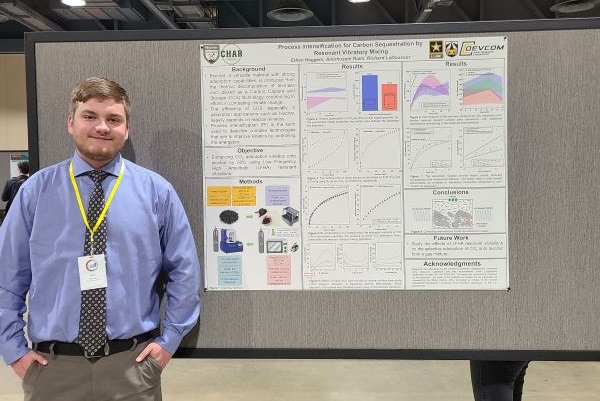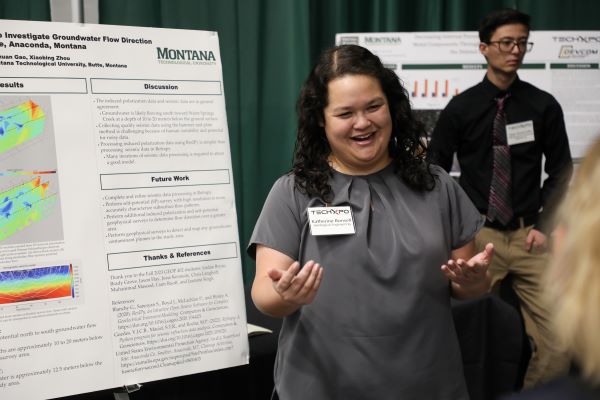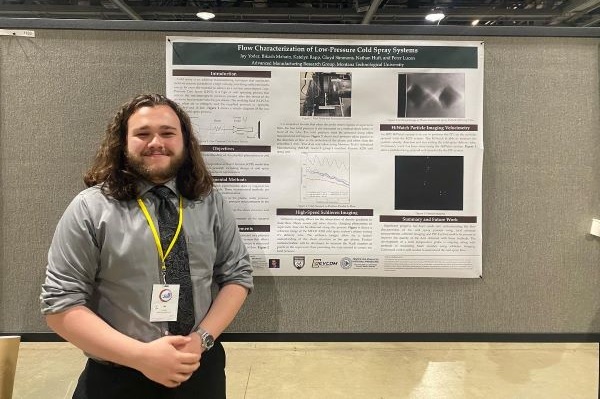Three Montana Tech students present posters at National Conference on Undergraduate Research
Three students from Montana Technological University attended the National Conference on Undergraduate Research (NCUR) 2024 on April 8-10, 2024 in Long Beach, California. The conference gives undergraduates from a wide variety of disciplines the opportunity to present their research.

Mechanical engineering junior Ethan Heggem, of Butte, presented a poster, “Biochar Adsorption for Carbon Capture and Sequestration from Local Biomass Sources Utilizing Low-Frequency, High-Amplitude Vibrational Mixing.”
Heggem performs undergraduate research in Dr. Richard LaDouceur’s laboratory, alongside Ph.D. candidate Amirhosein Riahi. The team works with powdered biochar to sequester carbon dioxide. Biochar resembles charcoal, and is the substance that is left over after biomass has been burned without oxygen
“The surface is full of micropores and macropores,” Heggem said. “It has such a high surface area that there’s a lot of room to attach molecules and that is what we are taking advantage of.”
Carbon dioxide is pumped into a vibratory mixer in LaDouceur’s lab. The mixer shakes the biochar in the chamber at a low resonant frequency.
“We are able to absorb more CO2 onto the surface of the biochar with the vibratory mixing,” Heggem said.
The project is funded by the DEVCOM Army Research Laboratory. Sequestration of carbon dioxide through biochar is of interest to the scientific communities because it could be used as a tool to help fight climate change by lowering the amount of greenhouse gas in Earth’s atmosphere.
Heggem says he met another student studying a similar topic at the conference, and they exchanged information for possible collaboration in the future.
“It was a one-in-a-million opportunity that we would meet there,” Heggem said. “The conference was inspirational. You have all these undergraduates from every discipline imaginable. You get to see how far you can take research in any field. I would implore any Montana Tech student to ask your advisor and see if you have a valid research project to present at NCUR.”
Katherine Bonsell, a geological engineering junior from Goleta, California, presented, "Integrating Multiple Geophysical Methods to Investigate Groundwater Flow Direction at the Old Works Golf Course, Anaconda, Montana.” Her research is conducted under Dr. Xiaobing Zhou, professor of geological engineering.

Bonsell’s research takes place at the Old Works Golf Course in Anaconda. The course was built as part of environmental remediation for the Anaconda Superfund site, and Bonsell performs geophysical surveys to collect data on groundwater location and depth on the course. Bonsell utilizes seismic refraction tomography and induced polarization tomography to determine the seismic velocities and resistivities of subsurface materials respectively. The ultimate goal is to find groundwater flow paths to identify where the groundwater is entering Warm Springs Creek. This could inform future work that may want to try to treat the groundwater to remove contamination before it enters the creek.
Bonsell had good conversations about her poster with people from as close as Bozeman and as far away as Wisconsin. Her experience at the conference was positive.
“It was very interdisciplinary,” Bonsell said. “I had only been to geology and mining-focused conferences before. It was interesting to see the art displays and humanities research presentations.”
Jay Yoder, a mechanical engineering senior from Plentywood, presented his poster, "Flow Characterization of Low-Pressure Cold Spray Systems.” This project is also funded by the DEVCOM Army Research Laboratory.

Yoder had attended another research conference last summer, but this one was bigger, with more than 4,000 students presenting.
“It was interesting to see a lot of different majors and research areas represented,” Yoder said. “I hunted down the other mechanical engineering research posters. Discussing their posters really helped my understanding of my own research.”
Yoder conducts research in the Montana Tech Advanced Manufacturing (MTAM) Research Group, led by Drs. Peter Lucon and Nathan Huft. Cold spray is a type of additive manufacturing where metallic or ceramic powder is accelerated to supersonic speeds to hit and bond to a substrate. It’s mainly used to repair cracks in metal parts including rotorcraft aluminum parts and hydro turbines in dams.
“There’s a gap in knowledge in what happens when the materials hit the gas stream and when they hit the substrate,” Yoder said. “We are trying to study what is happening to the particles flight.”
Yoder uses a particle imaging velocimetry system to take photos of the particles and calculate how fast they travel. Schlieren photography is also used to see the flow of the material. It is useful in identifying density gradients, and shock and expansion waves. Yoder also takes pressure measurements throughout the plume to understand the airflow.
“The ultimate goal for all these measurements is to validate computational fluid dynamic models,” Yoder said.
Yoder says he enjoyed presenting his work at the conference, and he would recommend that students consider attending.
“I would encourage students to do the oral presentations,” Yoder said. “Sometimes, with the oral presentations, you don’t get as much interaction, but the interaction you receive is from people very interested in what you are presented on. When you present a poster, you are speaking to a much more general audience.”